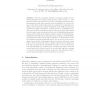Free Online Productivity Tools
i2Speak
i2Symbol
i2OCR
iTex2Img
iWeb2Print
iWeb2Shot
i2Type
iPdf2Split
iPdf2Merge
i2Bopomofo
i2Arabic
i2Style
i2Image
i2PDF
iLatex2Rtf
Sci2ools
ECCV
2008
Springer
2008
Springer
Multi-layered Decomposition of Recurrent Scenes
Abstract. There is considerable interest in techniques capable of identifying anomalies and unusual events in busy outdoor scenes, e.g. road junctions. Many approaches achieve this by exploiting deviations in spatial appearance from some expected norm accumulated by a model over time. In this work we show that much can be gained from explicitly modelling temporal aspects in detail. Specifically, many traffic junctions are regulated by lights controlled by a timing device of considerable precision, and it is in these situations that we advocate a model which learns periodic spatio-temporal patterns with a view to highlighting anomalous events such as broken-down vehicles, traffic accidents, or pedestrians jaywalking. More specifically, by estimating autocovariance of self-similarity, used previously in the context gait recognition, we characterize a scene by identifying a global fundamental period. As our model, we introduce a spatio-temporal grid of histograms built in accordance with ...
Computer Vision | Context Gait Recognition | ECCV 2008 | Periodic Spatio-temporal Patterns | Road Junctions | Road Traffic Junction | Traffic Junctions |
| Added | 15 Oct 2009 |
| Updated | 15 Oct 2009 |
| Type | Conference |
| Year | 2008 |
| Where | ECCV |
| Authors | David Mark Russell, Shaogang Gong |
Comments (0)

